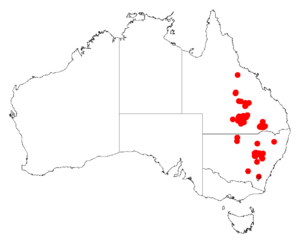Motherumbung facts for kids
Quick facts for kids Motherumbung |
|
|---|---|
| Scientific classification | |
| Genus: |
Acacia
|
| Species: |
ixodes
|
 |
|
| Occurrence data from AVH | |
The Motherumbung (scientific name: Acacia ixodes) is a type of shrub. It belongs to the Acacia family, which is also known as wattles. This plant grows naturally in parts of eastern Australia.
What Does Motherumbung Look Like?
This shrub usually grows to be about 2 to 7 m (6 ft 7 in to 23 ft 0 in) (about 6 to 23 feet) tall. It stands up straight and can spread out. Its branches are smooth and a bit sticky, especially near the ends.
Like most Acacia plants, the Motherumbung has special leaf-like parts called phyllodes instead of true leaves. These phyllodes are narrow and can be straight or slightly curved. They are about 2.5 to 5 cm (0.98 to 1.97 in) (1 to 2 inches) long and 2 to 5 mm (0.079 to 0.197 in) (0.08 to 0.2 inches) wide. They have one main vein that stands out.
The Motherumbung produces bright yellow flowers. These flowers appear between August and November. They grow in round or oval-shaped clusters, called flower-heads, which are about 4.5 to 7 mm (0.18 to 0.28 in) (0.18 to 0.28 inches) across. Each flower-head has 20 to 30 small flowers.
How Motherumbung Got Its Name
The Motherumbung was first officially described in 1980 by a botanist named Leslie Pedley. He wrote about it in a science journal called Austrobaileya.
Later, in 1987, Pedley changed its scientific name to Racosperma ixodes. But then, in 2001, it was changed back to Acacia ixodes. The word "ixodes" in its name refers to how sticky its new shoots and young phyllodes are.
Where Motherumbung Grows
This shrub is found across a large area in central New South Wales and goes into Queensland. In New South Wales, you can mostly find it growing between Dubbo, Gilgandra, and Mendooran.

